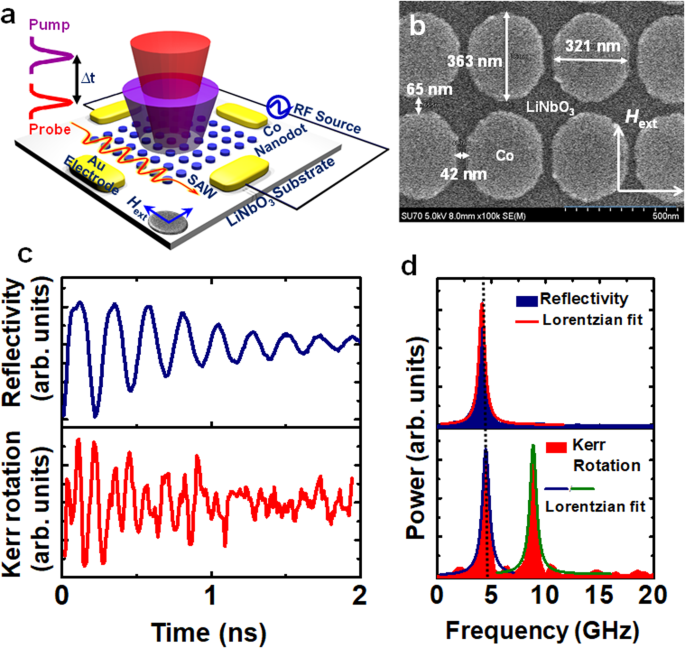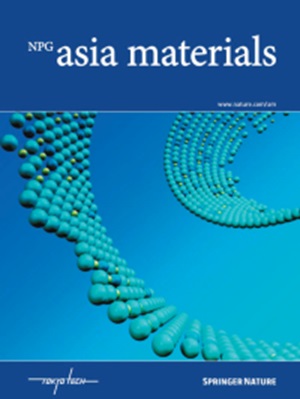Formation of binary magnon polaron in a two-dimensional artificial magneto-elastic crystal
IF 8.3
2区 材料科学
Q1 MATERIALS SCIENCE, MULTIDISCIPLINARY
引用次数: 0
Abstract
We observed strong tripartite magnon-phonon-magnon coupling in a two-dimensional periodic array of magnetostrictive nanomagnets deposited on a piezoelectric substrate, forming a 2D magnetoelastic “crystal”; the coupling occurred between two Kittel-type spin wave (magnon) modes and a (non-Kittel) magnetoelastic spin wave mode caused by a surface acoustic wave (SAW) (phonons). The strongest coupling occurred when the frequencies and wavevectors of the three modes matched, leading to perfect phase matching. We achieved this condition by carefully engineering the frequency of the SAW, the nanomagnet dimensions and the bias magnetic field that determined the frequencies of the two Kittel-type modes. The strong coupling (cooperativity factor exceeding unity) led to the formation of a new quasi-particle, called a binary magnon-polaron, accompanied by nearly complete (~100%) transfer of energy from the magnetoelastic mode to the two Kittel-type modes. This coupling phenomenon exhibited significant anisotropy since the array did not have rotational symmetry in space. The experimental observations were in good agreement with the theoretical simulations. This article reveals a study on magnon-phonon coupling in two-dimensional artificial magneto-elastic crystals. Researchers fabricated a 2D periodic array of magnetostrictive nanomagnets on a piezoelectric substrate and observed strong tripartite coupling involving two magnons and a phonon. This coupling transfers all or nearly all of the power from a magneto-elastic mode caused by surface acoustic waves (SAWs) to two Kittel-type spin wave modes. The findings highlight the importance of engineering SAW frequency, magnetic field, and nanomagnet dimensions to ensure near-perfect phase matching between all modes. This discovery could pave the way for future developments in energy-efficient computing, communications, and data storage. A two-dimensional array of magnetostrictive nanomagnets was used to demonstrate strong coupling between two different magnons (kM1′ and kM1′′) mediated by a phonon (kph). The coupling is strong, leading to the formation of a new quasi-particle – binary magnon-polaron. These two different magnons show 180° phase difference which is reminiscent of dark magnon modes. We show that it is possible to engineer this magnon-phonon coupling by choosing the frequency and wavelength of the acoustic wave to match the frequency and wavelength of the spin wave, the latter being controlled by a magnetic field.


二维人工磁弹性晶体中二元磁振子极化子的形成
我们观察到磁致伸缩纳米磁体沉积在压电衬底上的二维周期阵列中存在强的磁振子-声子-磁振子耦合,形成二维磁弹性“晶体”;耦合发生在两种基特尔型自旋波(磁振子)模式和由表面声波(声子)引起的(非基特尔)磁弹性自旋波模式之间。当三种模式的频率和波向量相匹配时,耦合最强,相位匹配完美。我们通过精心设计SAW的频率、纳米磁铁尺寸和决定两种kittel型模式频率的偏置磁场来实现这一条件。强耦合(协同因子超过1)导致了一种新的准粒子的形成,称为二元磁non-极化子,伴随着几乎完全(~100%)的能量从磁弹性模式转移到两个kittel型模式。这种耦合现象表现出明显的各向异性,因为阵列在空间上不具有旋转对称性。实验结果与理论模拟结果吻合较好。本文对二维人工磁弹性晶体中的磁子-声子耦合进行了研究。研究人员在压电衬底上制造了一个二维磁致伸缩纳米磁体周期阵列,并观察到两个磁振子和一个声子的强三方耦合。这种耦合将所有或几乎所有的能量从表面声波(saw)引起的磁弹性模式转移到两个kittel型自旋波模式。研究结果强调了工程SAW频率、磁场和纳米磁铁尺寸对于确保所有模式之间近乎完美的相位匹配的重要性。这一发现将为未来节能计算、通信和数据存储的发展铺平道路。利用二维磁致伸缩纳米磁体阵列来证明由声子(kph)介导的两种不同的磁振子(kM1 '和kM1 ")之间的强耦合。耦合是强的,导致形成一个新的准粒子-二元磁non-极化子。这两种不同的磁振子表现出180°的相位差,这让人联想到暗磁振子模式。我们表明,可以通过选择声波的频率和波长来匹配自旋波的频率和波长来设计这种磁子-声子耦合,后者由磁场控制。
本文章由计算机程序翻译,如有差异,请以英文原文为准。
求助全文
约1分钟内获得全文
求助全文
来源期刊

Npg Asia Materials
MATERIALS SCIENCE, MULTIDISCIPLINARY-
CiteScore
15.40
自引率
1.00%
发文量
87
审稿时长
2 months
期刊介绍:
NPG Asia Materials is an open access, international journal that publishes peer-reviewed review and primary research articles in the field of materials sciences. The journal has a global outlook and reach, with a base in the Asia-Pacific region to reflect the significant and growing output of materials research from this area. The target audience for NPG Asia Materials is scientists and researchers involved in materials research, covering a wide range of disciplines including physical and chemical sciences, biotechnology, and nanotechnology. The journal particularly welcomes high-quality articles from rapidly advancing areas that bridge the gap between materials science and engineering, as well as the classical disciplines of physics, chemistry, and biology. NPG Asia Materials is abstracted/indexed in Journal Citation Reports/Science Edition Web of Knowledge, Google Scholar, Chemical Abstract Services, Scopus, Ulrichsweb (ProQuest), and Scirus.
 求助内容:
求助内容: 应助结果提醒方式:
应助结果提醒方式:


